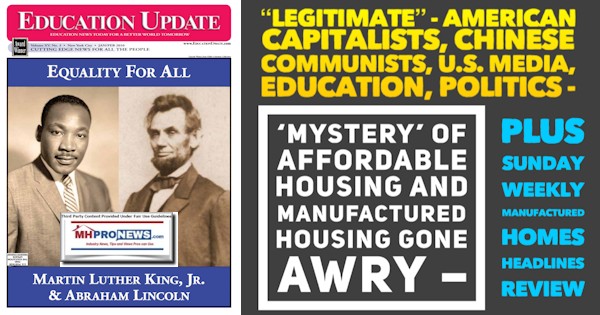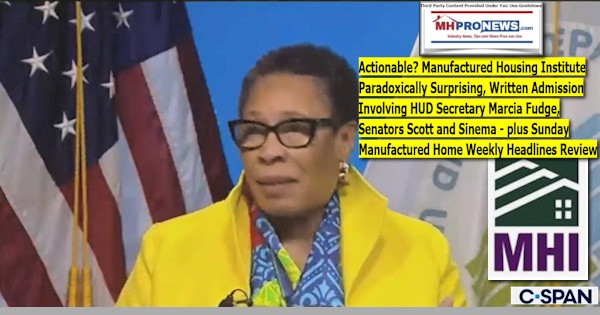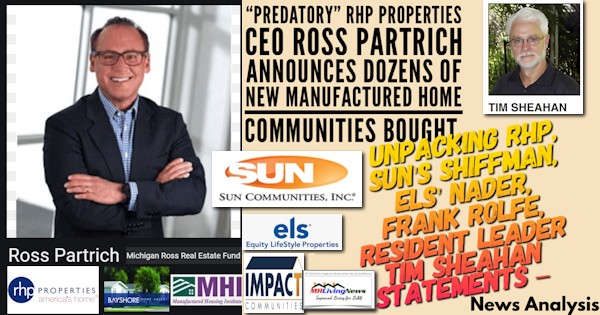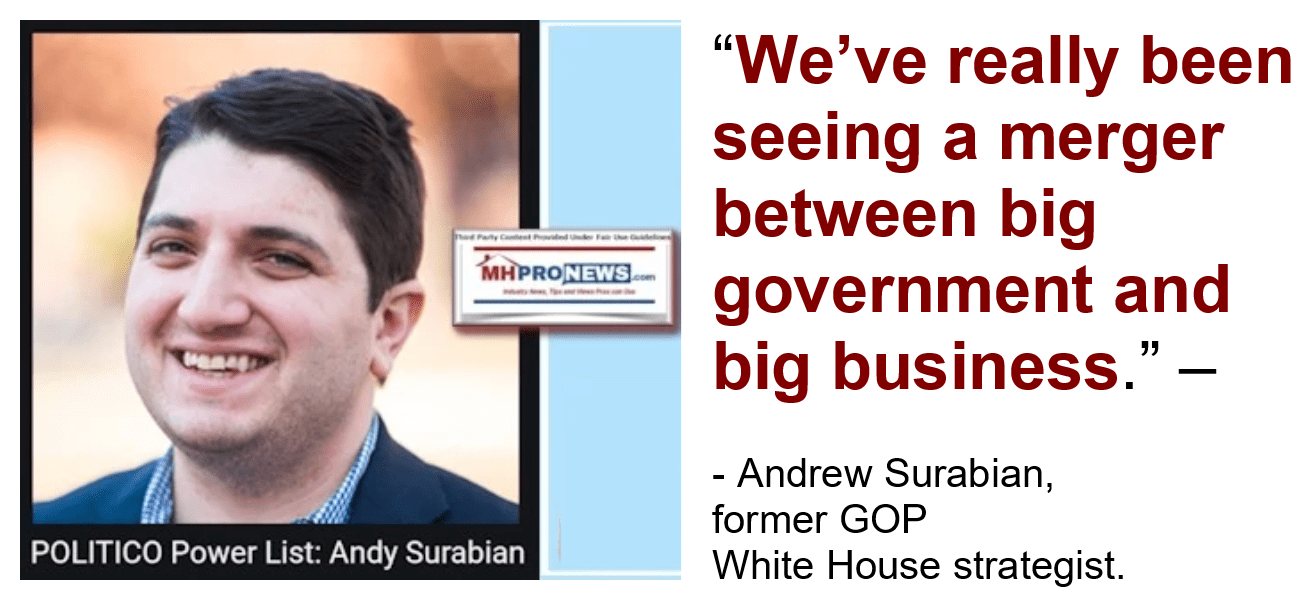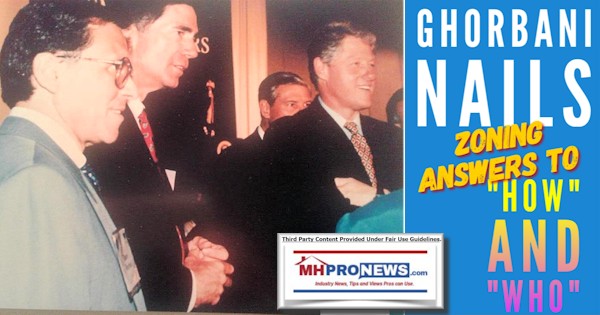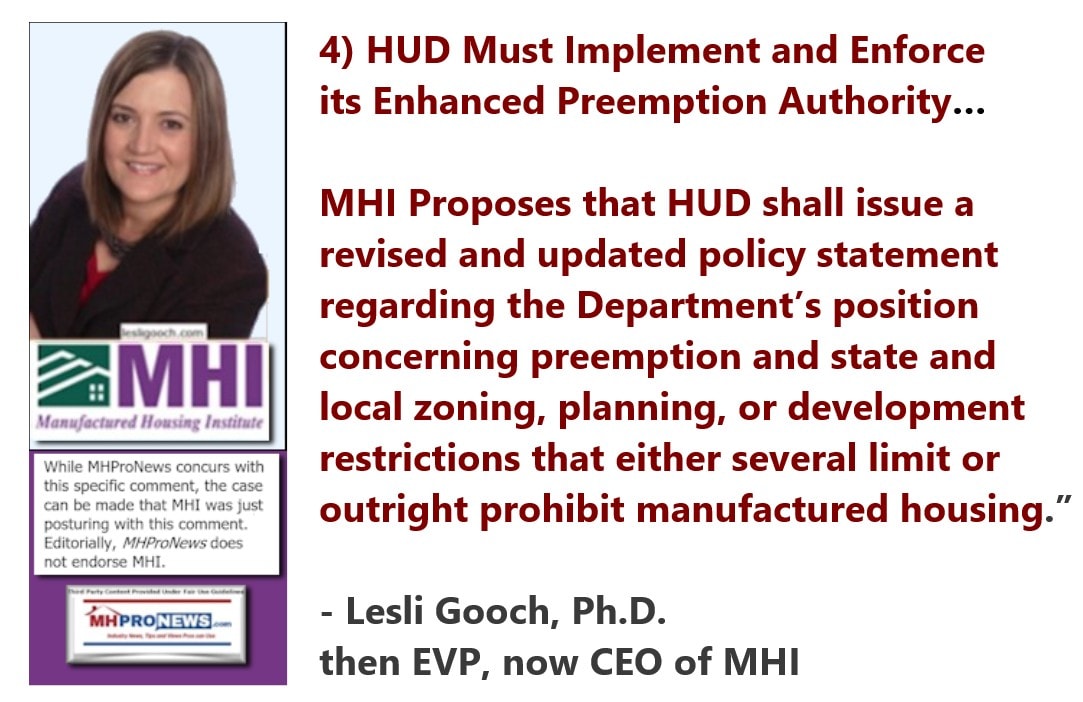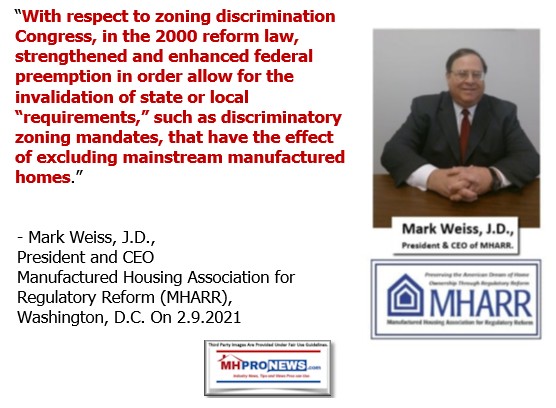It was on 12.13.2015 that award-winning consumer affairs journalist Jan Hollingsworth did a report on the zoning and placement problems vexing manufactured housing that included comments from Clayton Homes, an independent manufactured housing retailer, and then-MHEC member Jay Hamilton. It was entitled “Local Star Chambers Wage War on Affordable Housing.” MHProNews and MHLivingNews have been doing industry-leading reports and interviews on this topic for years. Fast forward to August 12, 2020. Almost one year has passed since MHProNews conducted an exclusive Q&A-style interview on the issue of zoning and placement with Danny Ghorbani. That prior interview is highly relevant to this new shown below. That previous interview is referenced by Ghorbani and this writer in the new Q&A shown below. For that fuller context, the prior interview is linked here.
This specific Q&A with Ghorbani was planned weeks in advance. It was sheer happenstance that the stunning yet revealing statements by HUD Secretary Marcia Fudge emerged, as was shown in a video with transcript obtained by MHProNews and posted at this link here. Among the top-line quotes by Secretary Fudge? Manufactured housing’s zoning and placement woes will continue “Until we [HUD and lawmakers in their oversight capacity] start to address this we are going to continue to be perpetually in this kind of situation.” Despite that dark assessment from the top official at HUD on the prospects for manufactured housing overcoming decades of zoning and placement woes, the Manufactured Housing Institute (MHI) oddly touted that exchange with various lawmakers as “MHI in Action.” But MHI did so without telling their own members and readers about that specific quote or other stunning ones found in that transcript.
Those comments by lawmakers and HUD Secretary Fudge made during the Congressional hearing were anything but a win for the industry’s independents and affordable housing consumers. Instead, the text of the discussion revealed it to be a sobering warning to independents and to those seeking or advocating for affordable housing and manufactured homes instead.
Rephrased, the pie-in-the-sky from MHI has apparently been precisely that. Which means the Q&A below is all the more important.
Because Ghorbani has uniquely served both MHI as a vice president and then became the founding president and CEO of the Manufactured Housing Association for Regulatory Reform (MHARR), his vantagepoint and insights are absolutely distinctive. Ghorbani also had the stunning achievement of having been MHI’s point-man in developing some 200,000 home sites, among other accomplishments that landed him in the RV MH Hall of Fame years before it arguably became politicized.
Therefore, this Q&A with Ghorbani cannot be overstated in its historic context and current significance.
For newcomers, note that “production” in this context refers to the interests of producers or builders of HUD-Code manufactured homes. “Post production” means those aspects of manufactured housing interests that occur after federally-regulated HUD-Code homes leave the factory. MHARR is a manufactured home producers (production) focused trade group. By contrast, MHI is an umbrella trade group that describes itself as representing a “all segments” of manufactured housing, meaning MHI claims to cover post-production interests too.
This Q&A will be followed by a focused MHProNews commentary that will link to additional related information.
DISCRIMINATORY AND EXCLUSIONARY ZONING LAWS
MHProNews THIRD Q&A with Danny Ghorbani
MHProNews QUESTION

Danny Ghorbani ANSWER
Thanks, Tony.
As I explained in greater detail in my answer to your Question No. 2, continuing discriminatory and exclusionary zoning laws against the manufactured housing industry and its consumers are no longer a result and/or a byproduct of manufactured homes’ “placement” on a piece of land (i.e., in the case of a single and self-contained lot) and/or a collective group of individual properties confined to and contained within a given area (i.e., in the case of developments, communities, planned unit developments, resorts, etc.). I explained that the manufactured home industry has already fought and won those battles, as evidenced by today’s modern, quality and up-to-date manufactured housing communities and developments which are equal to — if not better than — their site-built counterparts. Those discriminatory and exclusionary laws adopted by local governments against manufactured housing were subtle and nearly all based on one or a combination of prevailing characteristics such as income, race, socio-economic, life-style, class, site-work, aesthetics of the home, etc. Very few, if any, local governments would dare to do that today, subtle or otherwise. And if they did, they would likely find themselves on the losing side of a legal challenge.
The zoning battleground has been shifting for years, especially since the enactment of the 2000 Reform Law. States, local governments, and zoning boards these days are much smarter than our industry gives them credit for. They have studied and learned the intricate details of the 2000 Reform Law and nearly all of them understand it and its far-reaching ramifications better than most people in our own industry. While they rarely admit it openly or publicly, they now know that our homes are no longer the trailers and mobile homes of yesteryear, but modern, high-quality dwellings to be lived in permanently, just like any other type of housing.
So, today’s zoning boards, which include, among others, site-builders, realtors, suppliers, financiers, planners, union members and site-developers, just to name a few, have been slowly, quietly, and subtly using the differences between the Federal manufactured housing code (i.e., the HUD Code) and other types of building codes (i.e., International Residential Code and/or its various derivatives) as their main weapon to keep manufactured homes out of their jurisdictions. They have gradually switched their reason(s) for not allowing manufactured homes in their jurisdictions away from the characteristics and/or profile of the homeowner, to the home itself.
Thus, a new and different version of the “Not In My Backyard – NIMBY” argument (a phrase made famous by the late HUD Secretary, Jack Kemp), is now being applied against manufactured homes. According to their various arguments, manufactured homes are not permitted in their jurisdictions because they are built in compliance with a HUD Code that is not on par with – or is allegedly inferior to — other types of homes and the code(s) they are built to, which are allowed in their jurisdictions.
The zoning battle ground now is about the parity, or the lack thereof, between these two codes, and such zoning laws, in reality, are challenging the HUD Code and manufactured homes, which carry the “good housekeeping” seal of approval of the United States Government.
Given the fact that industry manufacturers, since the enactment of the 2000 Reform Law, are building their best homes ever, how did the industry get to this point? The answer may well be found in the fact that while the representation of the industry’s post-production sector was, is, and continues to be, either non-existent, incompetent or dysfunctional, the post-production assets, benefits and advantages flowing from the 2000 Reform Law continue to be spinned, twisted, misused and abused by its foes, competitors and outright enemies. They continue to do their homework, learning how to argue and deviously use those same assets, benefits, and advantages of the 2000 Reform Law against the industry. They continue to chip away at such assets, benefits, and advantages that various law(s) grant the industry and consumers, once today’s modern and quality manufactured homes leave the factory (e.g., enhanced preemption, fair zoning, availability of consumer finance at comparable rates, parity with other types of housing in all the government-sponsored housing, finance and community programs, just to name a few). As an aside to this particular matter, these folks are the same people that the Manufactured Housing Institute (MHI), the industry’s so-called post production representation, constantly brags about “working with” and forming groups and coalitions on one matter or another — never mind that these people have their knives out, ready to cut our industry’s throat when it really matters and counts, like when they serve on the zoning boards.
In any event, how should our industry utilize the “enhanced preemption” of the 2000 Reform Law to fight and win the zoning battle? It’s not an easy task, but is do-able, if — and this is a big if –, there is the will to do so, and here is how.
To begin with, the industry should review, renew, and refresh its knowledge and understanding of all the relevant factors about the federal law and related regulations, as well as their intended and/or not intended ramifications in order to fight the discriminatory and exclusionary zoning laws against manufactured homes. They should then be streamlined to identify the collective combination and application of the factors that will help to devise a master plan of action and a corresponding strategy that can be utilized to rid the industry and consumers of all discriminatory and exclusionary zoning laws, once and for all. Some of these factors may sound and/or look quite basic, but I strongly doubt if many people have given them any thought as part and parcel of the big picture for a successful plan of action and strategy.
Below are some of these relevant factors, not listed in any particular order:
- Manufactured housing is the only segment of the housing industry in the United States which is fully and comprehensively regulated by the federal government.
- The U.S. Department of Housing and Urban development (HUD) is the federal agency primarily in charge of manufactured housing law(s) and regulation.
- Manufactured homes are built in compliance with a federal performance-based uniform code (HUD Code).
- HUD Code and standards are enforced through a uniform set of federal enforcement regulations.
- HUD Code standards and regulation preempt all other state and local building codes and regulations.
- Federal law establishes a partnership between the federal and state governments in dealing with manufactured housing-related matters.
- HUD was created in 1960s as a federal agency in charge of the nation’s housing-related matters, nearly all of which were site-built housing at the time.
- While the HUD Code is a base code, producers can and routinely do build manufactured homes over and above this code, and in accordance with the homebuyer’s preference and/or home aesthetics required by local zoning laws.
- The 2000 Reform Law has fully and completely transformed the original 1974 law from a transitional law for the “mobile homes” of the past, to a law for today’s modern, high-quality, legitimate manufactured homes designed for permanent living.
- Non-federally owned lands in the U.S. are controlled, maintained, and managed by state and local governments.
- Federal law and regulations mandate a balance between consumer safety and the affordability of the home, making manufactured homes the best available source of unsubsidized homeownership for American consumers.
- To date, HUD has failed to fully, properly, and comprehensively implement all provisions of the 2000 Reform Law, particularly its critical “enhanced preemption” provision.
- The biggest casualties of HUD’s continuing failure to fully, properly, and comprehensively implement the “enhanced preemption” language of the 2000 Reform Law, are the homebuyers (particularly moderate and lower-income homebuyers) who are deprived of the best source of affordable homeownership.
- The biggest winners from HUD’s continuing failure to fully, properly, and comprehensively implement the “enhanced preemption” language of 2000 Reform Law, are state and local governments with discriminatory and exclusionary zoning laws against the manufactured housing industry and consumers, as well as the industry’s competitors.
- Together with the “purpose” and “findings” of the 2000 Reform Law, the “enhanced preemption” language of the 2000 Reform Law was carefully crafted to, among other things, acknowledge, reinforce, strengthen, and fully establish two main principles of the “preemption” provision of the original 1974 law, namely:
- To acknowledge vast improvements in the construction and safety of manufactured homes (production), and the gains in public acceptance and utilization of manufactured homes in the U.S. housing market (post production).
- To facilitate and advance HUD’s ability to fully, properly, and comprehensively enforce this section (i.e., preemption) of the law with its state partners and their respective local governments.
- There should be parity between manufactured housing and all other types of housing in all government sponsored housing, finance, and community programs.
- As a minority segment of the housing industry, nothing has or will ever be given to the manufactured housing industry and its consumers the easy way. They have to fight hard for every inch of their gains and benefits day in and day out in order to earn anything, even when the odds are fully in their favor (g., laws and mandates by U.S. Congress in favor of the industry and consumers)
A careful analysis of the above relevant factors, all rooted in truth, would clearly provide a path of “how” the enhanced preemption provision of the 2000 Reform Law can and must be used as the industry’s best and strongest weapon to fight and win the battle against discriminatory and exclusionary zoning laws.
All one has to do is to connect the proverbial dots among these existing factors and apply them to devise a plan of action and a corresponding strategy on behalf of a class of beneficiaries who have been harmed, in a major, aggressive and relentless legal challenge, all the way to the United States Supreme Court for a landmark decision to end decades of ugly, disgusting and debilitating discrimination and exclusion against the industry and its consumers.
This is a fairly straightforward undertaking given the fact that, by law, HUD is in charge of — and responsible for – the construction and safety of manufactured homes in full compliance with its own code and regulation. HUD thus not only has a responsibility, but a duty to make sure that its state partners and their respective local governments do not use the HUD Code and regulation as a tool to discriminate against manufactured housing by excluding them from all or part of their jurisdictions.
Ideally, HUD should voluntarily be the plaintiff in such a legal challenge because it must stand-up for its code, its regulations, and its process, as well as its final product.
Given the fact, though, that HUD is a creation of the site-built housing industry and its allies, I would not hold my breath waiting for it to do so. But, HUD should be encouraged, cajoled or, in the worst case, forced to take action.
And this brings us to the second part of your question as to “who” should lead this fight.
Under normal circumstances, the ideal entity would be the industry’s national and independent post-production association, if one actually existed.
Unfortunately, though, this is not the case. Those of us who were fully involved and engaged in leading the twelve-year-struggle through the legislative process and the ultimate enactment of the 2000 Reform Law were well aware and concerned all along that this would be a difficult bridge (i.e., post production matters vis-a-vis the 2000 reform Law) to cross at some point in the future. We were confident that the “production” provision of the law would be in good hands, given the long-established commitment of MHARR as its guardian.
The suspicion and concern, however – which continues to date – is as to who would protect, defend, and advance the implementation of the critical “post-production” provisions of the law, such as preemption, zoning, consumer finance, and parity with other types of housing, just to name a few.
Simply put, the industry currently does not have such an entity, and this is why all the post production matters are in a free fall and getting worse.
That being said, maybe all is not lost because MHI, which continues to collect dues and serves as the industry’s de-facto post production representation, knows only too well that these post production problems, and particularly the discriminatory and exclusionary zoning laws, not only are not being resolved, but are getting worse, blocking progress and prosperity for its own members and the broader industry as well.
You may recall that I ended my answer to your Question No. 2 by asking MHI if it knows how to fight and win the industry’s zoning battles. Now, here we have shown and given them the exact blueprint as to “how” to do this and maybe MHI can even “do it” because even a broken clock gives the right time twice a day. ##
Danny D. Ghorbani
202/262-2170
###
Additional Information, MHProNews Analysis, plus more Related Commentary
The above merits reading and re-reading for a range of reasons. For instance. MHProNews has conducted numerous interviews and Q&As over the years via email. They have included professionals who were members or staff with the Manufactured Housing Institute (MHI), the Manufactured Housing Association for Regulatory Reform (MHARR), public officials who were – or still are – in key positions in various federal agencies, are elected officials, and so on. In some ways, Q&A’s via email are the best. Why? Because the respondent to the inquiry has an opportunity to carefully consider her or his response. From years of experience, other than perhaps video interviews, an interview or Q&A via email is often the best way to avoid post-publication disputes that amount to ‘he said, she said,’ or ‘what I meant to say was’ types of disagreements. By contrast, a video interview can have unintentional slips or trips. Videos may make for drama later, but they may or may not reflect some person or organization’s actual stance. While each type of interview has a role, the worst kind of interview, arguably, is one where the person questioned is simply trusting that the person asking questions and taking notes is getting it all down and reporting it accurately — or not. Yet it is that later style of ‘interview’ that is perhaps still the most common in digital or actual print media.
MHProNews prefers the emailed interview, as was done with Ghorbani.
That is noted for several reasons. Among them is this. Ghorbani sent his response via email to MHProNews on Thursday, July 22, 2021 at 12:27 AM ET. He had no notion that MHProNews was about to publish the report linked below.
That report linked above included specifically quoted insights from MHI. MHI does not send their emails to MHARR. Thus, those insights obtained by MHProNews are proven all the more significant. Carefully reading both this Q&A with Ghorbani, and doing so in the light of what MHI said, and what Secretary Fudge and lawmakers did each illustrated in various ways the very concerns and statements made by Ghorbani.
It would be simple to say that Ghorbani claims that MHI has made its own bed and then wrap this report up.
But instead, this analysis will now see how the facts, evidence, and history of this key issue lines up, or not, with Ghorbani’s contentions.
As MHProNews previously documented, using an MHI-sourced item shown below, that before and for a brief time after the enactment of the 2000 Reform Law (the MHIA), MHI – and MHARR were, at least on paper, on the same side.
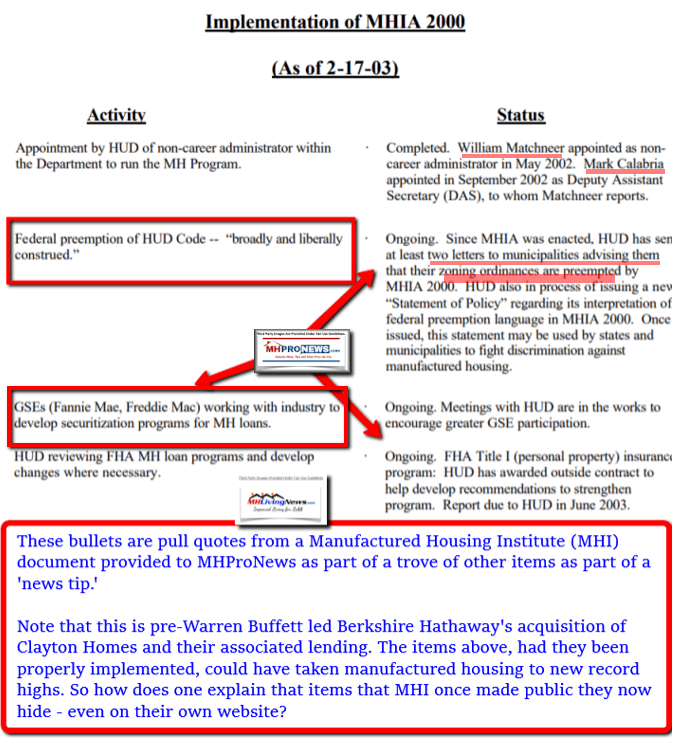
MHI, with the obvious approval of their elected and appointed leadership team – have made choices to align themselves, as Ghorbani noted, with the industry’s rivals. That’s not a mere allegation. As with his other statements, they are each based upon facts and discernable evidence. MHI made that stunning yet repeatedly self-admitted statement that they are in a coalition with the industry’s rivals, they just do not admit that those other nonprofits are rivals.
Ghorbani is quite correct. There is no independent post-production trade group representing the industry. There arguably should be, as MHARR has repeatedly noted. MHProNews has periodically made similar points about the need for a post-production trade group that is independent of MHI too, in reports that in some cases were years before the one found on the MHARR website.
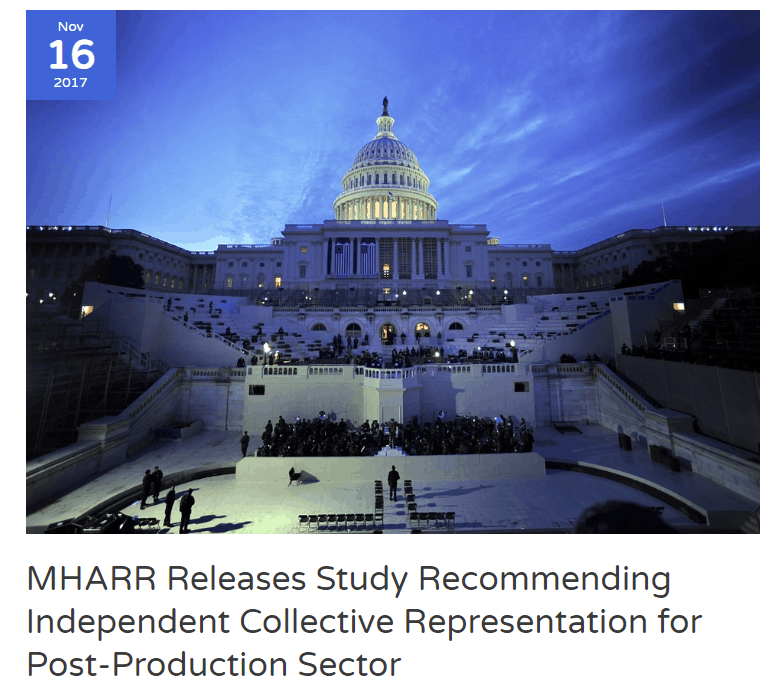
Next, it was MHI’s prior chairman, Tim Williams, that argued that there is a value to having an independent trade publisher.
Williams, who is president and CEO of 21st Mortgage Corporation, then praised MHProNews/MHLivingNews as just such an independent publisher. As MHI and MHARR both know, we have at various times agreed and disagreed, privately and publicly, on certain issues. Both MHI, MHARR, and members of each have at various times sponsored ads on MHProNews and/or MHLivingNews.
To rephrase, our views are not bought and sold. We present other people’s thoughts by quoting them accurately. Then, we present our own MHProNews analysis, additional information, and commentary independent of that commentary. It is all clearly labeled for what it is.
That is a long way to say the following.
- Years of evidence suggests that MHI has indeed boxed themselves in, as Ghorbani pointed out.
- MHI claims they represent all segments of manufactured housing.
- MHI signs certain documents under penalties of perjury every year. Those documents are first reviewed, per MHI, by their executive committee. In them, they say that they are working to “EXPAND THE DEMAND FOR MANUFACTURED HOMES” (all caps in the MHI original) by “SEEKING FAIR AND EQUITABLE TREATMENT IN THE MARKETPLACE AND THE REGULATORY AND LEGISLATIVE ARENAS.” That obviously covers zoning and placement.
- Additionally, Kevin Clayton and Tom Hodges – among other MHI members – have made testimony to Congress. That testimony, even when not under oath, is supposed to be factually accurate. Information that is deceptive or misleading can open them up to various penalties.
One more item that Ghorbani did not know was about to be published is the following.
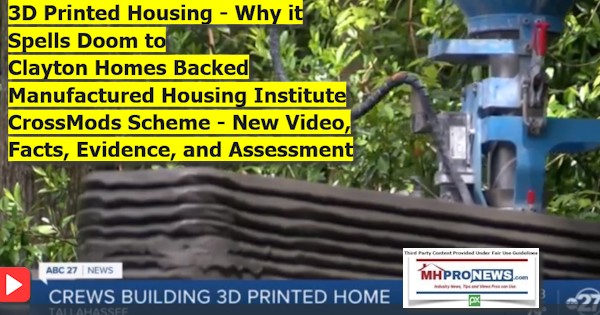
That report above was planned in advance of receipt of his response to MHProNews Q&A style interview. That said, it was tweaked to link Ghorbani’s response, once that was in our hands to reflect a reference to his comments.
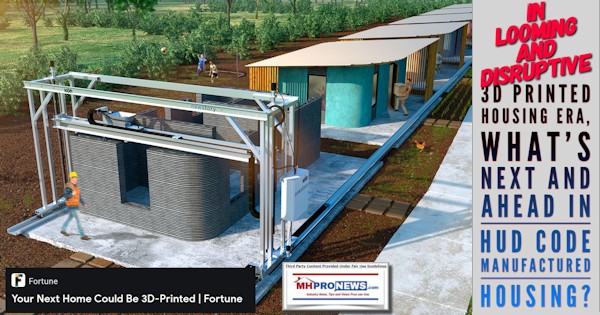
Then there is the report above. That report was planned after the receipt of Ghorbani’s answer. It should make it clear why this is not an issue that the industry can afford to put off any longer.
Let’s sum up.
1). HUD should be acting to defend the HUD Code with local zoning officials. Who said? Bill Matchneer, who is hardly a fan of MHARR. In fact, Matchneer was in several ways closer to MHI than MHARR.
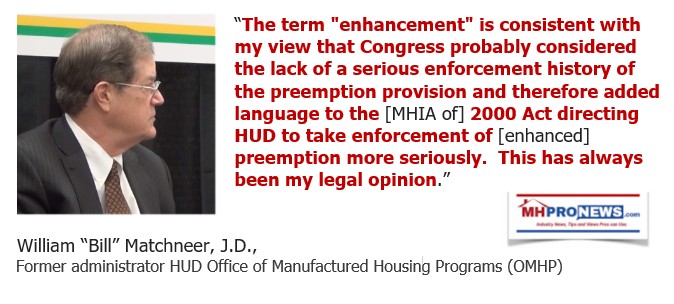
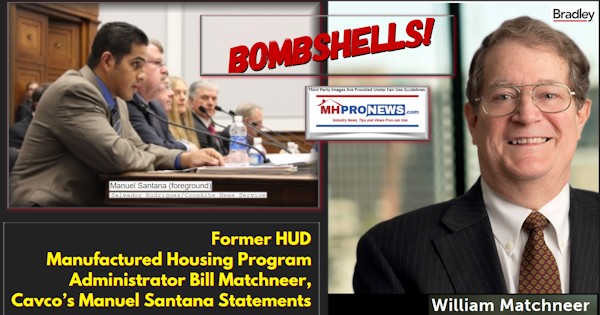
2). The fact that Matchneer and MHARR have not always been best pals make Matchneer’s comments all the more powerful. As the report linked above made clear, Matchneer said in no uncertain terms on a conference call with numerous HUD officials and industry members on the line that HUD’s Office of General Counsel failed to do what Matchneer felt the law called for – namely the enforcement of “enhanced preemption.”
3). One of MHI’s staff leaders – after months of public pressure by MHProNews/MHLivingNews – finally made the useful admission shown below.
4). Now MHI CEO Lesli Gooch, Ph.D., having finally responded, albeit obliquely, to MHProNews’ pressure is important. On paper, MHI largely admits the same points MHARR does. The law is what it is. But that then means that MHI has to do more than write a letter that gets no response. Now that Secretary Fudge is on-record with her comment, the case can be made that Ghorbani’s contention now comes into full focus.
5) Will MHI act? That is yet to be determined. But as OMHA’s Tim Williams interestingly called “scorched earth” campaign by MHProNews to push MHI into useful admissions, it should now be clear that MHI had little choice but to continue to admit the obvious again. MHProNews is aware of certain insider insights that can be deployed if necessary. The short version is that after years of dancing around the issues, see the examples linked and that follow, MHI has run out of runaway.
6). MHProNews has noted for years that on paper, there appears to be agreement on key issues between MHI and MHARR. But in reality, as Doug Ryan said, MHI is posturing in a fashion that benefits Clayton Homes and dominating brands. So, would be defenders of MHI, such as OMHA’s Williams and attorney Elizabeth Birch, have either missed the point, are turning a blind eye, or…whatever. Because there are a range of voices that are directly or indirectly pointing their finger toward MHI as the nonprofit organization that is near or at the heart of the industry’s failure to advance on zoning, placement, or other issues. When the law favors the industry, but the laws are not being properly enforced, and public officials will not act, what choice is left but for MHI to reach into its deep pockets and sue to enforce the law?
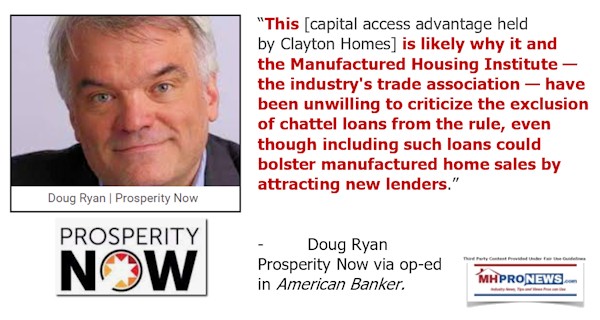
All of the above could be boiled down to this. Ghorbani has, in fact, demonstrably nailed it. MHI has made themselves the industry’s post-production and umbrella association, claiming to represent “all segments” of manufactured housing. MHI claimed that mantle. They own it. Whenever there is a zoning/placement issue, Ghorbani is correct — it is therefore up to MHI to do their job.

That logically means MHI has these choices.
- MHI could step up to the plate and authentically compel HUD to act, perhaps by using a Writ of Mandamus.
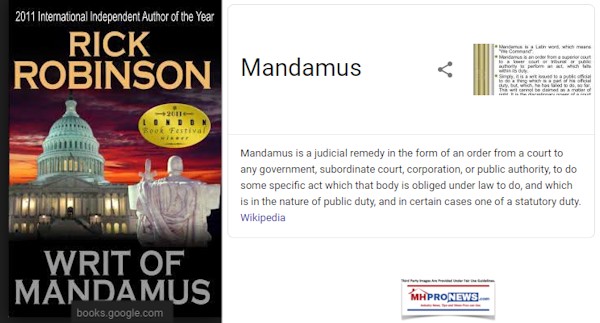
- MHI could properly select a case that has a favorable jurisdiction and circumstances. They could then authentically work to win in court what the facts, language, and legislative intent reveal should be a winnable case.
- Or, MHI can keep pretending to care about the industry’s independents and do what they have been doing. Nothing effective, but plenty of posturing. But if that is what they do – nothing – they would be proving MHI members Andy Gedo and Kevin Clayton both right. By limiting competition, and keeping barriers of entry in place, Clayton and their allies have gained a strong grasp of the industry. That is a contention that Berkshire, MHI, and Clayton’s attorney did not deny.
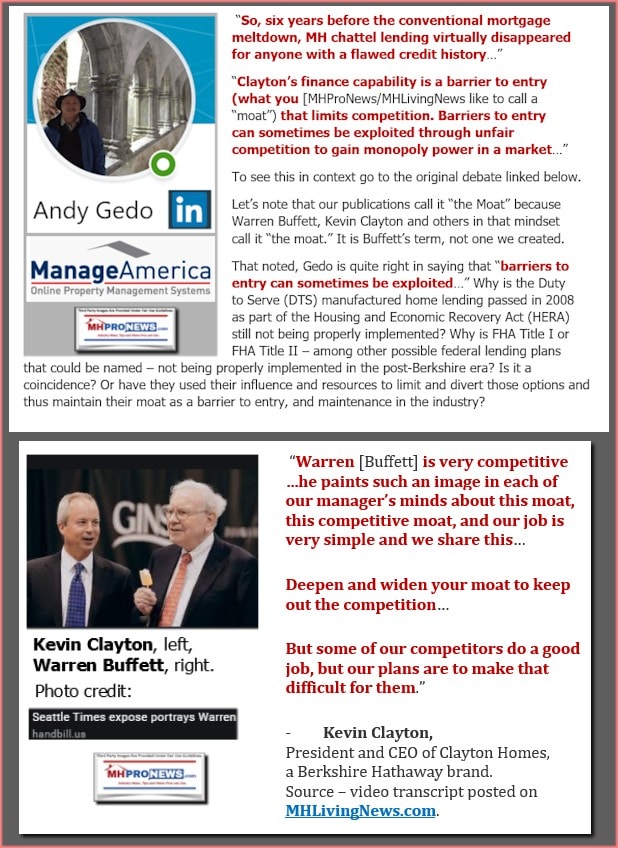
MHI has either been revealed to be a farce, a charade, as Samuel Strommen at Knudson Law alleged and laid out in a heavily footnoted ‘case.’ Even those who have read Strommen’s case previously should do so again in the light of Ghorbani’s carefully laid out thesis.
That report by Strommen is linked below. It clearly identifies MHI, and several of their dominating brands by name. It fits like a glove with Ghorbani’s contentions. Yet Strommen is from outside the industry and made his case based upon objective evidence that he cited.
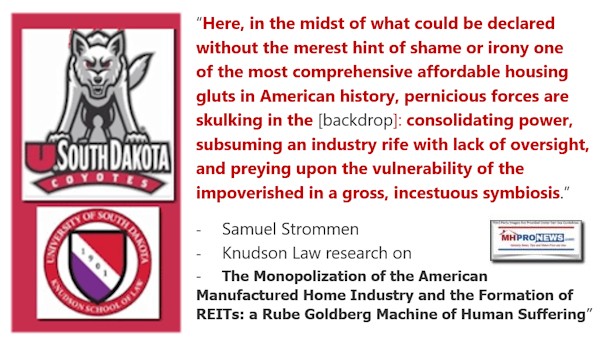
Ghorbani, without mentioning James A. “Jim” Schmitz Jr. and his colleagues made similar statements, see the report linked below as examples of the uncanny similarities. Meaning, outsiders looking in have often made similar points to the ones made by Ghorbani.
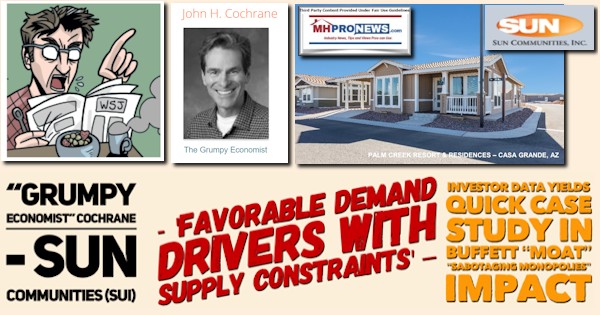
Summing up. Ghorbani indeed nailed it, as the headline suggested. He has effectively boxed MHI and their corporate masters into a proverbial corner.
Last and not least is the fact that Democratic lawmakers who helped enact the enhanced preemption clause have made a similar argument as the one quoted above from MHARR’s Mark Weiss. Those Democratic lawmakers did so in the context of a previous Republican-appointed HUD Secretary, Mel Martinez. They contended that HUD had the authority then that that current HUD Secretary Marcia Fudge recently denied she has.
It should be stressed that in that letter from House Democrats, which can be found in the report linked here, uses the same point made by MHARR’s current president and CEO Weiss, J.D., framed. That language was an critical element, a centerpiece, for enacting the MHIA or 2000 Reform Law. That wording of preempting local “requirements” makes it clear that no type of excuse can be used by local officials to bar the placement of HUD Code manufactured homes. In exchange for that enhanced preemption, the industry – under the same law – provides numerous consumer protections. Additionally, HUD’s own research, and a related comment by prior HUD Secretary Ben Carson citing FHFA research on manufactured housing, each illustrated that manufactured homes cited in urban settings next to conventional housing observed that both types of homes appreciated. A recent mainstream media report once more provided evidence that manufactured homes go up in value for similar reasons as other site-built housing does.
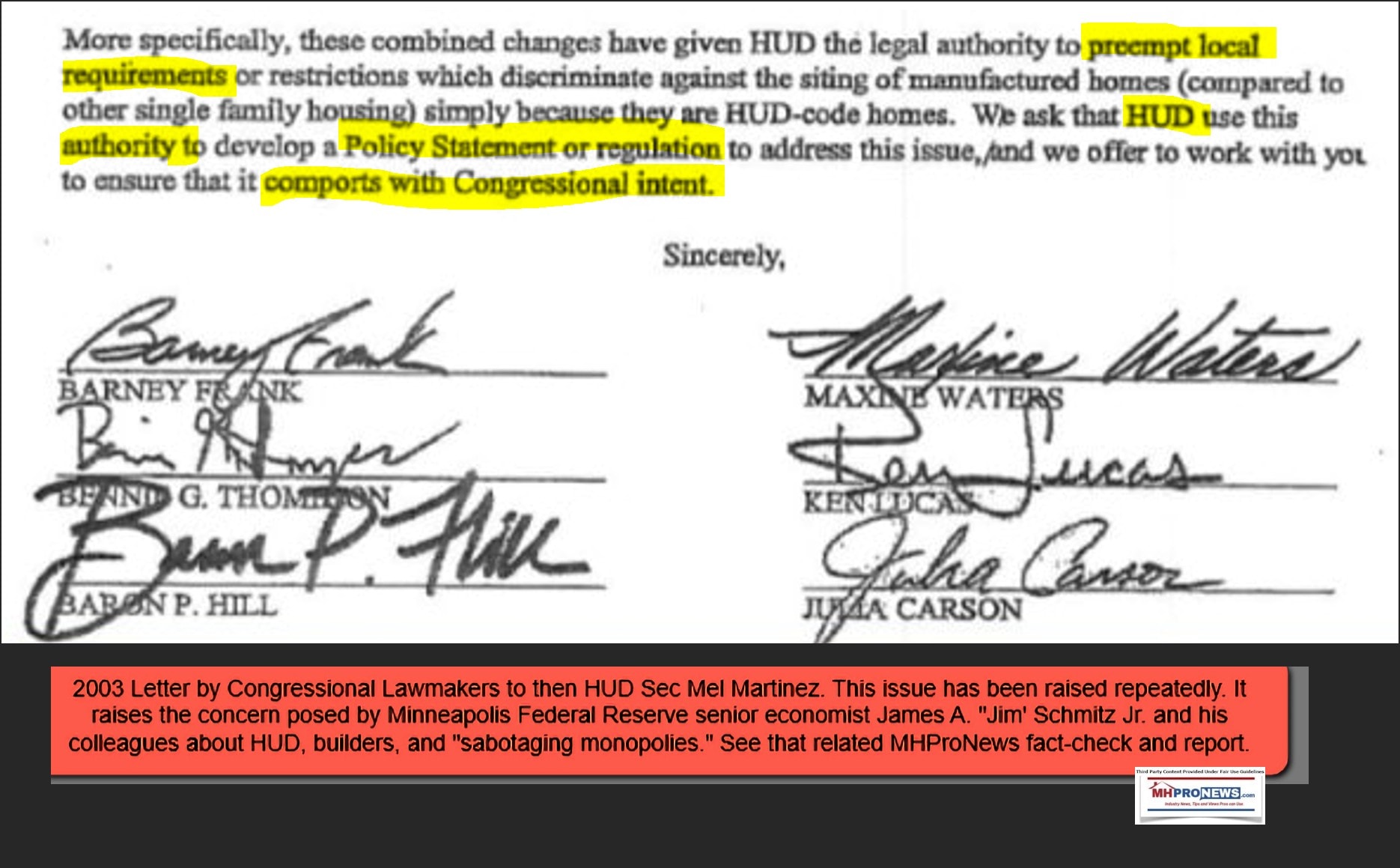
So, in this potent Q&A Ghorbani made the points that HUD has a duty, and so does MHI.
So now, the clock is ticking. What will MHI do – or not do – and when? What will HUD do – or not do – and when?
A planned report, that may appear as soon as this week, will reveal that this is a nonpartisan issue. That will be based upon statements from a senior HUD official to MHProNews. That report will reveal what is already suggested and obvious. Namely, that for various reasons, this long delay of enforcing “enhanced preemption” has spanned both Democratic and Republican administrations.
Ghorbani has made that HUD has a duty to enforce the law. Absent HUD doing its duty, it now clear that the ball is in MHI’s corner from the vantagepoint of industry association efforts.
Years of Effort, Paying Off?
Years of effort by MHARR, some voices known to MHProNews that are quietly at work within MHI that hate what they are doing/failing to do, and this trade publication are now at the point of the spear. MHI leaders – as well as official(s) at HUD – could soon be facing the music.
A traditional role of media is to hold the powerful to account. No one else in our industry’s trade media is even pretending to do that, save MHProNews and MHLivingNews. Even those who say we are “scorched earth” were giving backhanded praise. Because they albeit obliquely revealed that MHProNews was seeking to hold the powers that be at MHI to account for their years of failure to properly and effectively act.
In drawing to a conclusion, it should be noted that MHARR once more offered to go above and beyond their normal production-focused mandate by providing and opportunity to team up with one or more state associations to seek the kind of redress that Ghorbani is saying now falls to MHI. As MHARR’s Weiss explained, state executives – perhaps due to heat from the powers that be that dominate MHI and them too – failed to take up the MHARR offer.
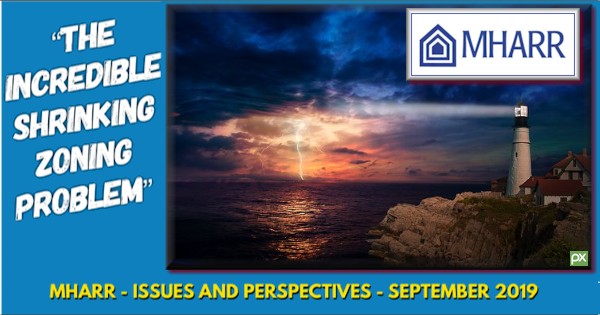
On issue after issue, MHI has mysteriously behaved in a manner that failed or foiled manufactured housing industry’s interests. By contrast, the evidence and history clearly reflects that each and every time MHARR was on the right side of a given issue from the perspective of advancing the interests of manufactured housing industry independents. MHARR pushed for implementing those policies that would have benefited more consumers and more independents.
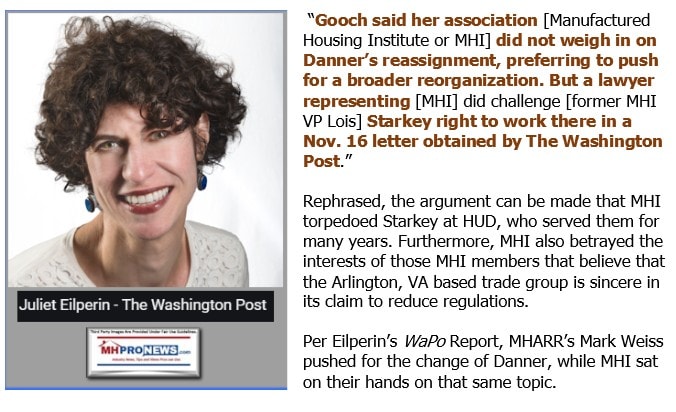
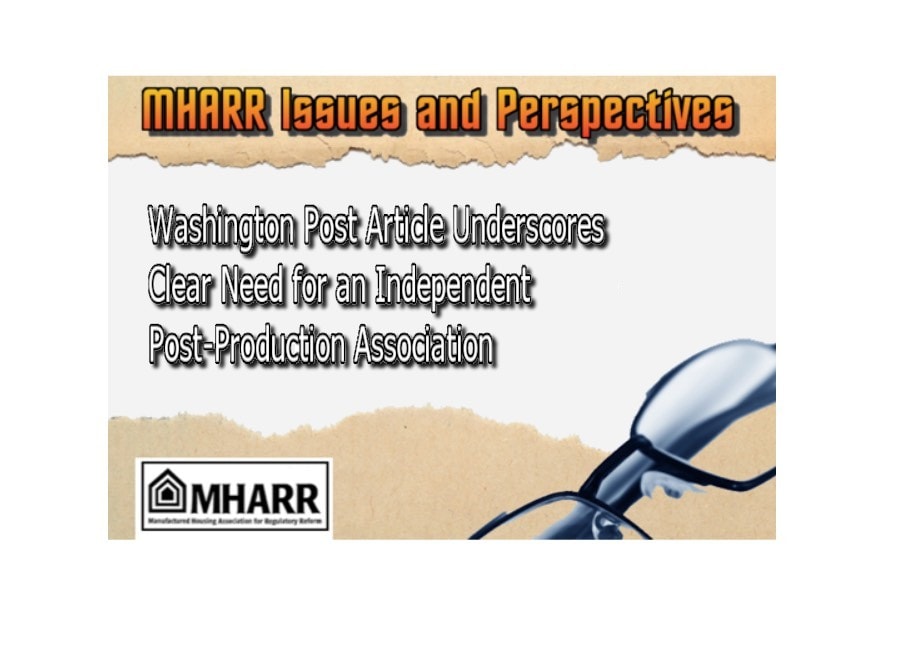
Ghorbani, Weiss, and MHARR have time and again proven to be correct. By contrast, MHI has proven to be either inept, wrong, or as some contend, corrupt in a fashion that is causing the industry to consolidate. Now that Ghorbani has nailed it, what will MHI do? What will HUD do?
To find out, stay tuned to the only trade media that takes the time and effort to sift through the competing claims, to separate the spin from reality, and then showcases where the facts and evidence lead. Because affordable housing is a major issue that impacts millions. Ghorbani and his colleagues have pointed the way to rapidly resolve the zoning and placement issues. It is now up to HUD – and if they won’t do it – then MHI to properly implement the law as it was intended.
###


Our thanks to you, our sources, and sponsors for making and keeping us the runaway number-one source for authentic “News through the lens of manufactured homes and factory-built housing” © where “We Provide, You Decide.” © ## (Affordable housing, manufactured homes, reports, fact-checks, analysis, and commentary. Third-party images or content are provided under fair use guidelines for media.) (See Related Reports, further below. Text/image boxes often are hot-linked to other reports that can be access by clicking on them.)

By L.A. “Tony” Kovach – for MHProNews.com.
Tony earned a journalism scholarship and earned numerous awards in history and in manufactured housing.
For example, he earned the prestigious Lottinville Award in history from the University of Oklahoma, where he studied history and business management. He’s a managing member and co-founder of LifeStyle Factory Homes, LLC, the parent company to MHProNews, and MHLivingNews.com.
This article reflects the LLC’s and/or the writer’s position, and may or may not reflect the views of sponsors or supporters.
Connect on LinkedIn: http://www.linkedin.com/in/latonykovach
Related References:
The text/image boxes below are linked to other reports, which can be accessed by clicking on them.
